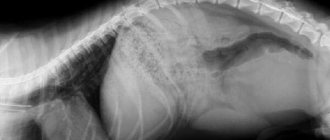Parvovirus enteritis in dogs has appeared relatively recently. The first outbreaks of the infectious disease were recorded in 1978. Then scientists noticed that the virus was similar to the one that infects minks and felines, however, its nature had significant differences from the above varieties.
The disease itself is extremely dangerous and if you do not contact a veterinarian in time, the dog will begin to dry out before your eyes and die after some time. It is for this reason that you should find out what form and severity of the disease the disease has, only then will a specialist select the correct therapeutic method and be able to cure your pet without serious complications.
General information about the disease
Parvovirus enteritis in dogs and canine distemper are different diseases, although many people confuse them. Parvovirus often affects the gastrointestinal tract, but can lead to serious problems and failures in other systems. The causative agents of the disease are divided into two types:
- When infected with the first type of pathogen, the animal’s cardiovascular, lymphatic and respiratory systems suffer. If a puppy gets this virus, death will occur in 98% of cases. Adult dogs with proper treatment have a high recovery rate.
- The second type occurs in vaccinated animals and has a mild course. Despite the fact that a vaccinated dog can get sick with parvovirus enteritis, it is necessary to vaccinate it, since in this case the disease will be mild and can be quickly stopped.
The enteritis virus infects cellular structures that rapidly divide. These include the cells of the intestinal mucosa, and it is the intestinal lining that suffers in most cases during the development of the disease.
Parvovirus has increased resistance to the external environment, so the rate of infection in dogs is extremely high.
Pathogens
Canine parvovirus or hemorrhagic enteritis (Parvovirus enteritis canine) is a highly contagious viral disease of canines with an acute course, which is caused by pathogens of the parvovirus genus. The disease is accompanied by vomiting, myocarditis, inflammation of the gastrointestinal tract of the hemorrhagic type, leukopenia, dehydration and death in puppies under five months of age.
The incubation period for parvovirus enteritis in dogs is 4 to 10 days, and in puppies it can last up to two months. This virus is similar to the feline distemper virus and mink enteritis virus, but it still has a number of differences. Animals of the canine family are susceptible to it, most often young dogs aged from two months to a year get sick.
Virus carriers
Virus carriers are sick or stray dogs that release the virus into the environment in their feces within ten days after the development of the disease. In addition, the virus can spread through saliva, and in addition to dogs, it can also be transmitted by people, rodents and insects.
In the natural environment, the disease is observed in dogs of various age categories. Infection often occurs through consumption of food and water that a sick dog had previously eaten, as well as through sniffing a sick animal or its feces.
Most often, the disease affects pets with low immunity, the decrease of which is caused by improper care, stress or helminthic infestations. Since the virus is resistant to the external environment and many antiseptics, it is extremely difficult to get rid of it. However, treatment with soda solution or sodium hypochlorite will destroy pathogenic microorganisms and clean the room, bedding and other items that were used by the sick animal.
Prevention
Since the virus is transmitted from one dog to another, you should not walk your pet in places where unvaccinated dogs walk.
Before the exhibition, all dogs are kept in quarantine. The period is 30 days. And pets are allowed to participate in such exhibitions when the owners have documents in their hands indicating a good state of health and the presence of all necessary vaccinations (including against parvovirus enteritis).
The dog must be kept clean. Regular disinfection of premises and organized feeding reduces the risk of infection with an infectious agent. To do this, use a 2% or 3% sodium solution. Sodium hydroxide or formaldehyde may also be used.
All puppies must be vaccinated according to the vaccination schedule. If it turns out that the dog is sick, it is isolated, and the room is treated with disinfectant solutions daily. You can prevent it by strengthening your pet's immune system. To do this, you need to add all the necessary minerals and vitamins to your dog’s diet.
Animals at risk
Both adults and puppies can get hemorrhagic enteritis. However, puppies aged from one to two and a half months are considered at risk. Also, the age category of animals from two months to a year is particularly vulnerable.
If a dog does not eat properly, is often stressed, has recently undergone surgery, suffers from frequent gastrointestinal disorders, or has a helminthic infestation, the percentage of it getting enteritis increases significantly.
"Important! Veterinarians say that susceptibility to the disease does not depend on belonging to a particular breed. It is also noted that a dog that has had enteritis once becomes immune to the disease for the rest of its life, but there is no direct evidence for this theory.”
Causes of parvovirus enteritis in dogs
The disease develops due to the entry into the body of pathogenic microorganisms belonging to the parvovirus family, which are divided into two types:
- Type 1 viruses are found in the feces of healthy dogs and are not classified as pathogenic;
- viruses of the second type have their own DNA, they lack an envelope and are resistant to chemical and physical influences.
The main source of infection is the feces of sick animals. The virus is excreted in feces for ten days, and its maximum concentration reaches on the fifth day. The virus can remain in vomit for two to twelve days. Since it is resistant to the external environment, it can stay in it for up to two months.
If a small dose of the virus enters the animal’s body, the disease will be asymptomatic. If a large amount of it enters the body, it is characterized by the development of acute parvovirus enteritis.
A sick dog secretes pathogenic microorganisms for twenty-one days after infection. In addition, after recovery, it also remains contagious for some time. The causative agent of the disease continues to remain in the animal’s fur and on the paw pads for a long time.
Canine parvovirus can be transmitted in the following ways:
- through bowls, toys and other care items;
- when a healthy animal comes into contact with a sick one;
- through food eaten by an infected animal;
- from an owner who brought the virus on shoes or outerwear;
- through bowel movements.
The virus often enters a pet's body through the nose or mouth. The peak incidence occurs from March to October and the summer season.
What is parvovirus
The definition of parvovirus is a group of microorganisms united by a common characteristic - the ability to rapidly infect body cells. Since a pathogenic virus has only one DNA helix, it is not suitable for reproductive function. In order to reproduce, it is forced to use the “services” of other groups of cells. A harmful DNA helix is introduced into the genetic code of the selected cell, and the captured “victim” is forced to produce viral strains until its death.
Pathogenic bacteria awaken complex pathological processes in the dog’s body, bloody diarrhea, and intrauterine fetal death in a pregnant bitch. Since the discovery of the parvovirus strain, it has undergone various mutations and today it has been established that 80% of infections caused by parvovirus are caused by a genetically adapted helix of the CPV-2b virus.
Forms of the disease
Parvovirus enteritis in dogs can take three forms:
- cardiac. It is characterized by acute myocardial damage. The disease is diagnosed in puppies aged from two to eight weeks;
- intestinal The most common form of the disease. It has an acute or subacute form of flow. Signs of the disease include prolonged, repeated vomiting and complete refusal of water and food.
- mixed. This form of the disease is characterized by damage to the respiratory, cardiovascular and digestive systems. The disease often develops in animals with weak immune systems, puppies and unvaccinated dogs. The symptoms of this type of disease are varied.
Severe parvovirus enteritis in dogs can lead to death within six days of the first signs of infection. Without properly selected therapy, the animal dies, especially high mortality is observed among puppies. But even intensive treatment does not provide any guarantees. When intensive therapy is carried out, the animal recovers within one to five weeks, which is determined by the development of immunity in the sick dog.
Forecast
Statistics give conflicting figures for mortality from parvovirus among puppies:
- in the intestinal form – from 25 to 60%,
- for cardiac – from 70 to 90%.
The chances of a successful recovery increase with inpatient treatment in a veterinary clinic under the supervision of a doctor. The death of a puppy is not caused by the virus itself, but by the devastating consequences of infection:
- dehydration;
- exhaustion;
- bacterial infection;
- intoxication;
- acute heart failure.
Even treating veterinarians do not undertake to predict the outcome of the disease in puppies, leaving the chances 50 to 50. The 4th day from the moment the initial symptoms appear is considered a turning point. If the puppy survives, he does not get worse - the prognosis is favorable. The immune system begins to produce antibodies. They block the introduction of the virus into cells and gradually remove the pathogen from the body. The animal is recovering.
Puppies that have recovered from the disease develop strong immunity. It lasts for at least 3 years, according to some virologists – for life.
Symptoms of the disease
Parvovirus enteritis is a very insidious disease, as it is accompanied by a large number of symptoms that make it difficult to diagnose. Sometimes it happens that the disease manifests itself weakly and the owner does not even suspect that his pet is sick. In the case of this disease, not only the absence of complications, but also the life of the dog depends on how timely it is detected.
In order not to miss the initial symptoms of parvovirus enteritis in a dog, the owner should carefully monitor the animal and record any, even minor, deviations in its behavior. If infection is suspected, the dog should be shown to a veterinarian.
Symptoms of parvovirus include:
- lethargy. The animal ceases to be active, reacts sluggishly to what is happening around it and mostly lies down;
- increase in temperature indicators. The dog's temperature rises above 39 degrees, which is evidence of the development of a viral disease. However, it should be taken into account that it increases immediately before the death of the animal, so you need to pay attention to other symptoms and prevent the temperature from increasing.
- painful sensations. Pain often occurs during the incubation period. It manifests itself in the arching of the back when stroking and the dog’s attempts to move away. Pain is the first sign of the onset of the disease.
- urge to vomit. These symptoms appear in the first few days after the end of the incubation period. At first, the vomit contains undigested food, but later it consists only of grayish mucus.
- diarrhea. At first, the animal's feces are liquid with a yellowish or greenish tint, later it becomes watery and bloody due to the appearance of ulcerations in the intestines and stomach.
A sick animal stops eating and drinking, as a result of which the body quickly loses moisture and becomes dehydrated. Due to severe pain and rapidly developing heart failure, the pet can die within a few days if timely assistance is not provided to it.
Literature
- Animal Pet Doctor
- Zhao J et al (2011) Origin and evolution of canine parvovirus—a review. Wei Sheng Wu Xue Bao 51(7):869–875
- Parrish CR & Kawaoka Y (2005) The origins of new pandemic viruses: the acquisition of new host ranges by canine parvovirus and influenza A viruses. Annu Rev Microbiol 59:553–586
- Tsao J et al (1991) The three-dimensional structure of canine parvovirus and its functional implications. Science 251:1456–1464
- Kaelber JT et al (2012) Evolutionary reconstructions of the transferrin receptor of Caniforms supports canine parvovirus being a re-emerged and not a novel pathogen in dogs. PLoS Pathog 8(5):e1002666
- Hafenstein S et al (2007) Asymmetric binding of transferrin receptor to parvovirus capsids. Proc Natl Acad Sci USA 104:6585–6589
- Parker JS & Parrish CR (2000) Cellular uptake and infection by canine parvovirus involves rapid dynamin-regulated clathrin-mediated endocytosis, followed by slower intracellular trafficking. J Virol 74:1919–1930
- Harbison CE et al (2008) The parvovirus capsid odyssey: from the cell surface to the nucleus. Trends Microbiol 16:208–214
- Allison AB et al (2012) Role of multiple hosts in the cross-species transmission and emergence of a pandemic parvovirus. J Virol 86(2):865–872
- Stucker KM et al (2012) The role of evolutionary intermediates in the host adaptation of canine parvovirus. J Virol 86(3):1514–1521
- Parrish CR et al (1985) Natural variation of canine parvovirus. Science 230:1046–1048
- Buonavoglia C et al (2001) Evidence for the evolution of canine parvovirus type-2 in Italy. J Gen Virol 82:3021–3025
- Martella V et al (2004) A canine parvovirus mutant is spreading in Italy. J Clin Microbiol 42:1333–1336
- Decaro N et al (2006) A minor groove binder probe real-time PCR assay for discrimination between type-2 based vaccines and field strains of canine parvovirus. J Virol Methods 136:65–70
- Decaro N et al (2007) Tissue disribution of the antigenic variants of canine parvovirus type 2 in dogs. Vet Microbiol 121:39–44
- Vieira JM et al (2008) Canine parvovirus 2c infection in central Portugal. J Vet Diagn Invest 20:488–491
- Parthiban S et al (2011) Isolation and Typing of Canine Parvovirus in CRFK Cell Line in Puducherry, South India. Indian J Microbiol 51(4):456–460
- Pinto LD et al (2012) Typing of canine parvovirus strains circulating in Brazil between 2008 and 2010. Virus Res 165(1):29–33
- Zicola A et al (2012) Fatal outbreaks in dogs associated with pantropic canine coronavirus in France and Belgium. J Small Anim Pract 53(5):297–300
- Clegg SR et al (2012) Canine parvovirus in asymptomatic feline carriers. Vet Microbiol 157(1-2):78-85
- Iris Kalli et al (2010) Factors affecting the occurrence, duration of hospitalization and final outcome in canine parvovirus infection. Res Vet Sci 89(2):174–178
- Ling M et al (2012) Risk factors for death from canine parvoviral-related disease in Australia. Vet Microbiol 158(3-4):280-290
- Brady S et al (2012) Canine parvovirus in Australia: the role of socio-economic factors in disease clusters. Vet J 193(2):522–528
- Schaudien D et al (2010) Leukoencephalopathy associated with parvovirus infection in Cretan hound puppies. J Clin Microbiol 48(9):3169–3175
- Pollock RV & Carmichael LE (1990) The Canine Parvoviruses. In: Tijssen P, editor. CRC Handbook of Parvoviruses. Vol. 2. Boca Raton: CRC Press, Inc. pp:113–134
- Schoeman JP et al (2013) Biomarkers in canine parvovirus enteritis. NZ Vet J Feb 15
- Goddard A et al (2008) Prognostic usefulness of blood leukocyte changes in canine parvoviral enteritis. J Vet Intern Med 22(2):309–316
- Mantione NL & Otto CM (2005) Characterization of the use of antiemetic agents in dogs with parvoviral enteritis treated at a veterinary teaching hospital: 77 cases (1997-2000). J Am Vet Med Assoc 227(11):1787–1793
- Kocaturk M et al (2012) Tei index (myocardial performance index) and cardiac biomarkers in dogs with parvoviral enteritis. Res Vet Sci 92(1):24–29
- Kocaturk M et al (2010) Prognostic value of serum acute-phase proteins in dogs with parvoviral enteritis. J Small Anim Pract 51(9):478–483
- Schoeman JP et al (2007) Serum cortisol and thyroxine concentrations as predictors of death in critically ill puppies with parvoviral diarrhea. J Am Vet Med Assoc 231(10):1534–1539
- Yilmaz Z & Senturk S (2007) Characterization of lipid profiles in dogs with parvoviral enteritis. J Small Anim Pract 48(11):643–650
- Markovich JE et al (2012) Effects of canine parvovirus strain variations on diagnostic test results and clinical management of enteritis in dogs. J Am Vet Med Assoc 241(1):66–72
- Van Nguyen S et al (2006) Passive protection of dogs against clinical disease due to Canine parvovirus-2 by specific antibody from chicken egg yolk. Can J Vet Res 70(1):62–64
- Haladová E et al (2012) Immunomodulatory effect of glucan on specific and nonspecific immunity after vaccination in puppies. Acta Vet Hung 59(1):77–86
- Savigny MR & Macintire DK (2010) Use of oseltamivir in the treatment of canine parvoviral enteritis. J Vet Emerg Crit Care (San Antonio) 20(1):132–142
- Duffy A et al (2010) Hematologic improvement in dogs with parvovirus infection treated with recombinant canine granulocyte-colony stimulating factor. J Vet Pharmacol Ther 33(4):352–356
- Dodds WJ et al (2012) Immune plasma for treatment of parvoviral gastroenteritis. J Am Vet Med Assoc 240(9):1056
- Bragg RF et al (2012) Clinical evaluation of a single dose of immune plasma for treatment of canine parvovirus infection. J Am Vet Med Assoc 240(6):700–704
- Ju C et al(2012) Genome Sequence of Canine Parvovirus Strain SC02/2011, Isolated from a Puppy with Severe Diarrhea in South China. J Virol 86(24):13805
- Soma T et al (2012) Analysis of the VP2 protein gene of canine parvovirus strains from affected dogs in Japan. Res Vet Sci Oct 11
- Martella V et al (2005) Immunogenicity of an intranasally administered modified live canine parvovirus type 2b vaccine in pups with maternally derived antibodies. Clin Diagn Lab Immunol 12(10):1243–1245
- Decaro N et al (2008) Evidence for immunization failure in adult dogs infected with canine parvovirus type 2c. New Microbiol 31(1):125–130
- Yoshikawa R et al (2011) Contamination of infectious RD-114 virus in vaccines produced using non-feline cell lines. Biologicals 39(1):33–37
- Yoshikawa R et al (2012) Presence of infectious RD-114 virus in a proportion of canine parvovirus isolates. J Vet Med Sci 74(3):347–350
- Dahiya SS et al (2012) Immunogenicity of a DNA-launched replicon-based canine parvovirus DNA vaccine expressing VP2 antigen in dogs. Res Vet Sci 93(2):1089–1097
- De Cramer KG et al (2011) Efficacy of vaccination at 4 and 6 weeks in the control of canine parvovirus. Vet Microbiol 149(1-2):126-132
- Mitchell S et al (2012) Duration of serological response to canine parvovirus-type 2, canine distemper virus, canine adenovirus type 1 and canine parainfluenza virus in client-owned dogs in Australia. Aust Vet J 90(12):468–473
- Taguchi M et al (2012) Booster effect of canine distemper, canine parvovirus infection and infectious canine hepatitis combination vaccine in domesticated adult dogs. Microbiol Immunol 56(8):579–582
^Top
Diagnostic measures
When a dog is brought to the veterinary clinic with suspected parvovirus enteritis, the veterinarian immediately conducts a preliminary diagnosis, including a rapid test for parvovirus enteritis in dogs to make an accurate diagnosis.
The primary and main symptoms of parvovirus are sudden onset of diarrhea mixed with blood, vomiting and dehydration of the body. Also, an infectious disease often leads to enlargement of the mesenteric lymph nodes, which is detected during palpation examination.
To confirm the presence of parvovirus enteritis in a dog, the doctor conducts a number of diagnostic tests, presented:
- Using the PCR method. It allows you to detect parvovirus in the animal’s feces, which led to the development of the disease.
- RGTA. A test to identify parvovirus.
- Electron microscopy. The diagnostic technique is aimed at studying the feces of a sick animal.
- ELISA (rapid test). This enzyme immunoassay is considered the most informative and reliable method for diagnosing parvovirus enteritis in dogs.
However, the above differential methods are also important for accurately diagnosing the disease. They help distinguish parvovirus from other types of enteritis, which may be caused by bacteria or toxins.
Diagnostics
A puppy with signs of enteritis needs emergency care. Treatment is prescribed immediately, the regimen is adjusted based on the results of laboratory tests. The following tests most accurately detect parvovirus:
- PCR (polymerase chain reaction) - detects the DNA of the virus even at an early stage. For analysis, feces or a smear of the rectal epithelium are taken. The method is highly sensitive and accurate. The duration of the study is from 1 to 3 days.
- ICA (immunochromatographic analysis) - detects parvovirus antigens in fecal samples 3 days after infection. The results are interpreted by the number of colored stripes: 2 lines – positive, 1 – negative. The express test is carried out directly in the veterinarian's office and lasts on average 10 minutes.
- ELISA (enzyme-linked immunosorbent assay) - the study is similar to the previous one, but more accurate due to the amplifier substrate.
Additionally, the composition of the blood is examined. Infection with parvovirus is indirectly confirmed by a decrease in the level of white blood cells. Laboratory tests help exclude enteritis of bacterial or parasitic origin, and infectious hepatitis with similar symptoms.
See also: Simparica - tablets against ticks and fleas. Puppies are allowed from 2 months.
Treatment of parvovirus enteritis
The incubation period in adult dogs lasts from four to ten days, and in puppies it can last up to two months. All this time the disease will be asymptomatic. And in order not to miss the first signs of the disease, at the slightest suspicion of parvovirus enteritis, you should consult a veterinarian.
Treatment of parvovirus enteritis in dogs is complex. It consists of the introduction of immunomodulators, antivirals, antibiotics, droppers to eliminate dehydration and other drugs according to the animal’s condition.
The main task at the first stage of treatment is to increase the body's defenses and stop the infection. Often the animal is given an injection of the antiviral drug “Fosprenil” and the immunomodulator “Immunofan”. The doctor also finds out whether the dog has been vaccinated. If he was not, he is additionally injected with Giskan serum. After identifying parvovirus in a dog and administering the necessary medications, you should monitor its health. If diarrhea with bloody inclusions appears, the pet is prescribed antibiotic therapy. And in case of vomiting and rapid dehydration of the animal, it is given Regidron and special drugs are dripped to stop dehydration.
Antiemetics, glucose and amino acids are used as maintenance therapy to nourish the body depleted by the disease. To relieve pain, the dog is injected with antispasmodics. And to improve cardiac activity, the animal is administered stimulant drugs. If there is a large amount of blood in the stool or vomit, then Vikasol is prescribed to stop the bleeding.
The treatment regimen for parvovirus enteritis in dogs is formed depending on the symptoms. Therapy is aimed not only at destroying viral agents, but also at maintaining the proper functioning of the cardiovascular and lymphatic systems, as well as healing the gastrointestinal mucosa that has been damaged by the virus.
Dog's diet during and after illness
At the initial stage of the disease, you should not feed your pet. He needs to be given ascorbic acid and glucose little by little. These drugs will help maintain vitality. Your veterinarian may also prescribe vitamins and probiotics.
The fasting diet must be followed for at least three days. Water can be given in small quantities, but only after the vomiting has passed. A day after its rebaptism, you can start giving the dog food that has been ground to a mushy state. Food should be given in divided doses and often, every three hours.
You can give your dog rice or flaxseed water, as well as chicken broth. If the animal refuses to eat on its own, food should be given from a syringe without a needle. After a while, you can gradually begin to introduce chopped eggs and noodles with chicken broth into your diet. You should also give boiled sea fish without bones, which will help quickly establish carbohydrate metabolism.
In order to normalize the intestinal microflora, the animal can be given yogurt or kefir without additives. Until complete recovery, the dog should not be given meat, milk, or fatty, sweet or salty foods.
After recovery, your pet needs to be provided with a nutritious diet, which will help quickly restore strength and improve immunity.
Regenerating drugs
After an acute period, you can support the puppy’s vitality with additional means:
- Vetom 1.1 is a feed additive for restoring the gastrointestinal microflora, stimulating digestion, and increasing resistance. The powder is added to water or food at a dose of 50 mg per kg of puppy weight. The course of taking Vetom is 1.1 – 2 – 3 weeks.
- Hemobalance is a drug for improving metabolic processes with vitamins, microelements, and amino acids. A single dose for a puppy up to 5 kg is 0.25 ml, from 5 to 15 - 0.5 ml, over 15 - 1 ml. Hemobalance is administered intramuscularly or taken 2-3 times a week.
- Catozal is a solution for strengthening the immune system and improving metabolism. A single dose for puppies is 0.1 – 0.3 ml. The schedule of injections is determined by the attending physician.
Is the disease dangerous for other animals?
Since parvovirus enteritis in dogs is transmitted to their fellow dogs, it must be taken into account that after the dog recovers, the virus can remain in the house or yard for six months despite treatment.
It is for this reason that during the illness the animal must be quarantined within one room and not allow other animals into it for six months. Also, you should not get a puppy within six months. It is better to do this a year after the pet’s illness, when there is no longer any danger to the new inhabitant of the house.
Recovery prognosis
The prognosis for a dog's recovery from parvovirus infection is based on several key factors:
- age of the animal;
- the pet has concomitant chronic illnesses;
- stage of development of the disease at the time of seeking veterinary help.
We advise you to learn how to identify and treat joint dysplasia in dogs.
The hyperacute form of the disease is fatal for 95% of puppies, especially if they are kept in one place by the breeder. In the acute form, the mortality rate is lower - 20–50%, although here too much depends on the separate keeping of animals. If a dog develops a subacute form of parvovirus enteritis with a longer course, the likelihood of a favorable outcome increases significantly. A rapid deterioration in the dog’s well-being foreshadows its quick death.
Complications of parvovirus enteritis
Unfortunately, this disease is fraught with complications that can develop after it is stopped. The consequences of parvovirus enteritis in dogs can be presented:
- intestinal adhesions;
- paralysis of limbs;
- obstruction of the gastrointestinal tract;
- infertility;
- intestinal rupture;
- inflammatory processes in the liver and pancreas;
- heart failure;
- peritonitis;
- myocarditis.
To minimize the risk of complications, you should vaccinate your animal and contact a veterinarian in a timely manner.
Consequences
Parvovirus in puppies younger than 3 months of age, when affecting the myocardium, often causes heart failure, which can be fatal several weeks or months after the illness.
Sometimes the infection has a negative effect on the reproductive system of dogs. Males that have recovered from the disease lose reproductive function for several months or become infertile for life.
Bitches whose virus has caused damage to ovarian tissue lose their ability to reproduce. Puppy dogs with parvovirus enteritis may exhibit abnormal embryonic development.
When the bone marrow is damaged, the production of leukocytes is disrupted, which leads to leukopenia.
Parvovirus enteritis, against the background of a decrease in the immune status of the body, often provokes secondary bacterial infections, which can cause alveolitis and pulmonary edema.
Disease prognosis
With timely treatment, the prognosis is 60%. If treatment was started late, then parvovirus leaves the dog virtually no chance. High mortality is observed in puppies, the rates are 95%.
Vaccination, proper dog care, and a timely visit to the veterinary clinic if dangerous symptoms appear will help prevent death.
The causative agent of infection
The disease in four-legged pets is caused by Canine parvovirus (CPV), or canine parvovirus. It is divided into 2 types:
- CPV-1 is a harmless type of pathogen that causes mild diarrhea in young animals;
- CPV-2 is a pathogenic and highly contagious strain that undermines the functioning of internal organs and often causes death in animals under 2 months of age.
The main feature of CPV is its high resistance to environmental factors. It is not afraid of sub-zero temperatures and is difficult to heat and disinfect. The virus retains its pathogenicity for up to 2 years, being outside a living organism and in a humid environment, protected from exposure to the sun, and when heated to 80°C it dies only in the 15th minute. To neutralize CPV at home, formaldehyde and chloride solutions are used.
Preventive actions
Prevention of viral enteritis in dogs consists of:
- timely vaccination;
- protecting your pet from contact with stray dogs;
- compliance with sanitary and hygienic standards in the house;
- keeping the dog's area clean.
In addition, you need to carefully monitor the animal’s condition and promptly contact a specialist.











